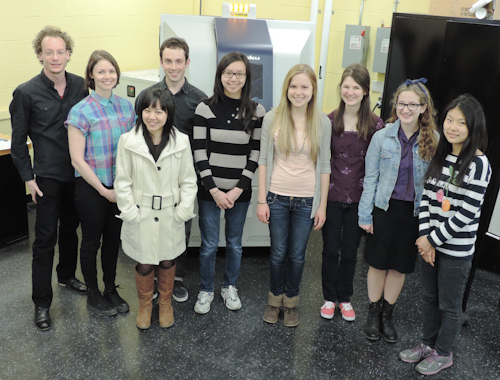Today’s Interview with an Author is with Maikel Rheinstädter, corresponding author on “The structure of people’s hair”, an article that we published last month. We were very interested in hearing more about his research and his experience publishing with us so we invited him to answer a few questions.
PJ: Can you tell us a bit about yourself?
MR: I run an experimental biophysics lab at McMaster University in Canada and study the organization of bio-molecules in different materials, such as biological and synthetic membranes, fibres, pens and also hair. We use X-ray diffraction to determine the molecular structure of these materials in their native state, under physiological conditions.
 Courtesy of Maikel Rheinstädter (most left person). Fei-Chi Yang (first author) is the third person from the left and Yuchen Zhang (second author) is the most right person.
Courtesy of Maikel Rheinstädter (most left person). Fei-Chi Yang (first author) is the third person from the left and Yuchen Zhang (second author) is the most right person.
PJ: Can you briefly explain the research you published in PeerJ?
MR: First of all the general structure of human hair is very well known from numerous studies. The idea to use a strand of hair for the diagnosis of certain diseases is quite intriguing as it is a painless, non-invasive procedure perfect for rapid screening. However, before we can identify abnormal features and potentially assign these features to certain diseases, we need to characterize healthy hair first. We, therefore, studied the molecular structure of hair from different (healthy) persons with different appearance of the hair, such as color and waviness and also genetic relationship. We identified common features and quantitatively determined their properties, and where you would see differences between different people. From Fig. 4 of the article – The hierarchical structure of hair
From Fig. 4 of the article – The hierarchical structure of hair
PJ: What surprised you the most with these results?
MR: The most surprising result was that the molecular structure and organization of the keratin molecules in human hair does not depend on the appearance of the hair (within the resolution of our experiment of course). Differences between different people were found in the composition of the membrane complex. This composition seems to be a unique feature, as unique as a genetic fingerprint.
PJ: What kinds of lessons do you hope the public takes away from the research?
MR: Using modern technology and analysis techniques, we are getting one step closer in using hair samples for the diagnosis of diseases, which will be much easier than for instance a biopsy or even a blood test.
PJ: Where do you hope to go from here?
MR: Now that we studied the differences between healthy hairs, the next step will be to investigate hair from patients with different diseases to search for potential anomalies in the molecular hair structure. One can also study the potential effect of hair care products on the molecular structure in more detail.
PJ: Why did you choose to reproduce the complete peer-review history of your article?
MR: I often find the review process not to be very transparent as an author, but also as reviewer of a manuscript. PeerJ’s approach to reproduce the complete peer review history is the perfect approach to make this process transparent and less nebulous and mysterious, in particular for new people. Publishing the name of reviewers also gives them credit for their hard work and often crucial input.
PJ: How did you first hear about PeerJ, and what persuaded you to submit to us?
MR: I very much like the idea of open access publishing and making scientific results accessible to a broad audience. So I was very excited when PeerJ was first announced. I browsed through the first papers when they came out and was blown away by the breadth of topics and in particular the online presentation of the articles. The PDF versions of the papers are just gorgeous, too. And looking at the metrics, the research is well found and looked at.
PJ: How would you describe your experience of our submission/review process?
MR: During the submission, review and production process I was impressed by the easiness and transparence. I felt as a partner in every step of the process. The people at PeerJ are very passionate about publishing! I was very surprised that I got replies to my emails sometimes within minutes, even over the weekend. People were always helpful and trying to come up with solutions quickly.
PJ: Did you get any comments from your colleagues about your publication with PeerJ?
MR: Not everybody knows PeerJ yet because it is still a new journal. Whenever I show it to my colleagues they are of course impressed by the online presentation of the articles and how you can browse a paper just like a web page.
PJ: Would you submit again, and would you recommend that your colleagues submit?
MR: Absolutely; the next paper is already in the pipe!
PJ: Many thanks for your time!
Join Maikel Rheinstädter and thousands of other satisfied PeerJ authors – send your next article to PeerJ and put the fun back into publishing! Don’t forget that in association with OA Week PeerJ is offering free publishing through the end of November.

